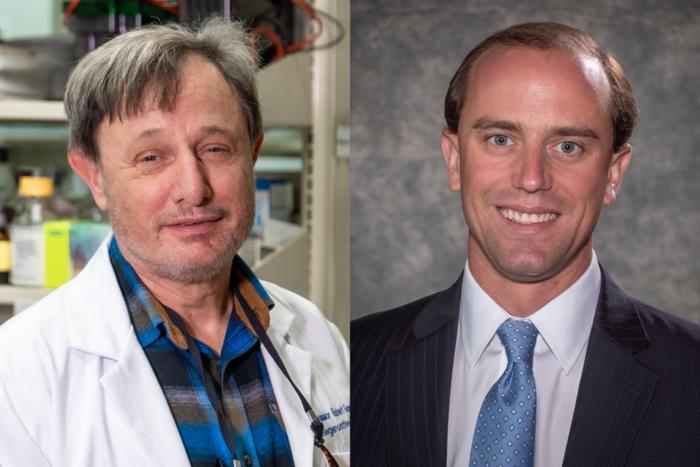When it comes to translational medicine, Robert Gourdie is among the 2 percent of “super-producers,” National Institutes of Health-funded scientists at U.S. biomedical institutions who hold 10 or more issued patents.

Credit: Virginia Tech
When it comes to translational medicine, Robert Gourdie is among the 2 percent of “super-producers,” National Institutes of Health-funded scientists at U.S. biomedical institutions who hold 10 or more issued patents.
Super-producers were responsible for half of all patents issued according to research published Aug. 11 in Nature Biotechnology. The objective of the research was to create a tool to better quantify bridges and barriers to clinical translation of biomedical discoveries.
The research marks a novel area of inquiry for Gourdie, a professor and cell biologist at the Fralin Biomedical Research Institute at VTC and director of the institute’s Center for Vascular and Heart Research. He also holds an appointment in the Department of Biomedical Engineering and Mechanics in the College of Engineering.
Gourdie was approached by Rocco DiSanto, then a student at the Virginia Tech Carilion School of Medicine, with an idea.
“I was trying to figure out how a good idea makes it from A to B,” DiSanto said. “How does it go from the graduate research environment into something that a working physician can put to use in the community?”
The inventor’s own success with patents, licensing, and commercialization made him the ideal mentor for DiSanto, who earned a master’s degree in biomedical engineering before starting medical school. He has since graduated and is in residency at the University of South Carolina School of Medicine.
“We shared a similar mindset, that science should leave the walls of the research center and have a broad impact in the world. In the American system, starting a company is one way to achieve broad impact,” DiSanto said.
Gourdie received Virginia Tech’s first NIH R35 Outstanding Investigator Award, is a fellow of American Institute for Medical and Biological Engineering, and in 2023 was named a senior member of the National Academy of Inventors.
Co-authors include Mark Van Dyke, professor and associate dean of research at the University of Arizona College of Engineering, and Michael J. Barker, an undergraduate student at Florida State University. Barker worked in Gourdie’s lab and Van Dyke previously was a faculty member in Virginia Tech’s department of biomedical engineering and mechanics.
WHAT THEY DID
Using a decade’s worth of data from the NIH and the U.S. Patent and Trademark Office, the team created a database that linked utility patents and both grant and non-grant awards at institutions that receive NIH funding.
Their approach to linking patents and funding included up-to-the-minute programming that enabled cross-checking and validating NIH and patent data. They scrutinized the “Government Interest” section of patents that legally mandates, and thus in theory incentivizes, inclusion of federal support, such as NIH grants. They then created a simple metric, the Translational Ratio, by dividing the total of that funding, including the sponsoring institution’s overhead, by the number of issued patents.
The lower the number, the lower the cost per patent.
The ratio facilitates comparisons between institutions and investigators to better analyze characteristics that signal success in moving discoveries from bench to bedside, which could be useful in stimulating future health innovation.
WHAT THEY FOUND
Researchers examined data from 2009 to 2019 from U.S. institutions with more than $40 million in NIH funding and at least 15 utility patents.
- The 201 Institutions that met the criteria were divided in three equal groups based on funding: low, moderate, and high. Researchers found that the cost per patent was lower at institutions with lower funding – an average of $9.2 million, compared with $15.8 million in the moderate- and $16 million in the high-funding groups.
- Overhead costs of the sponsoring institution did not affect patent efficiency. Researchers obtained facilities and administrative rates for 134 institutions in the study and split them into low- and high-costs groups; rates ranged from 42.6 percent to a high of 89.5 percent. The lower group’s average overhead rate of 51.2 percent translated to a per-patent cost of $15.4 million, while the higher group’s average rate of 61.4 percent translated to $15.7 million per patent.
- The presence of a well-funded engineering unit correlated with stronger patent production. The 114 institutions with colleges or schools of engineering or applied science were split in two based on engineering-department funding. The per-patent costs averaged $15.5 million among those with average funding of $84 million and $11.9 million per patent in the group with average funding of $575 million. Authors suggest this could be related to interdisciplinary collaboration paired with engineering’s enhanced focused on translating science into practice.
- “Super-producers” are responsible for the majority of NIH-associated patents. Investigators with 10 or more patents represented 2 percent of the study group, but half of all patents issued. Roughly one in five investigators were issued NIH-related patents related to their awards, evidence that relatively few investigators actively engage in patent production.
- Clusters of super-producers at individual institutions were associated with greater patent efficiency.The study’s authors suggest that institutions see an outsize lift in patent efficiency from well-resourced senior scientists whose research is more developed. Not only did those scientists likely benefit from early-stage support from the NIH, the authors suggest, but they are better positioned to take risks in an academic promotion system that values publications above patents.
HOW THIS HELPS
NIH-funded biomedical research serves as a vital source of funding to better understand the underlying mechanisms of disease, and it provides support for clinical trials to assess the safety and efficacy of potential treatments. The funding also plays a critical role in education and training, enabling scientists to pursue careers in academia, government, and industry.
Motivated in part by the pandemic, Congress pledged to transform biomedical and health research by establishing the Advanced Research Projects Agency for Health (ARPA-H) in 2022 and authorizing $1 billion to invest in high-potential discoveries through October 2024. They signaled ongoing commitment to that effort by budgeting another $1.5 billion in fiscal year 2023, and the administration has asked for $2.5 billion for fiscal year 2024.
While not exclusively focused on translational medicine, developing new treatments remains a strategic objective for the NIH. The translational ratio is a tool that can help assess the impact of NIH-funded research on drug innovation and treatment development.
“Foundational research findings, such as those funded by many NIH-supported studies, have a way of providing useful technologies that are not always presently obvious in the moment,” Gourdie said. “The strategic support of basic research is rare, fragile, and deserving of great and jealous protection. We hope that our database will assist institutions, such as the NIH and ARPA-H, more effectively achieve their goals of enhancing health, lengthening life, and reducing illness and disability.”
Journal
Nature Biotechnology
DOI
10.1038/s41587-023-01890-w
Method of Research
Meta-analysis
Subject of Research
Not applicable
Article Title
Comparing efficiency of patent production between US institutions using a hybrid NIH–USPTO dataset
Article Publication Date
11-Aug-2023
COI Statement
The authors declare no competing interests.




